
An SD40-2 has a Heart Attack On October 12, 2001 I was called at Laurel, MT for 2:30am for the H-PASKCK. It had 82 cars, 4372 tons, and three locos. The first two were C44s, BNSF 5327 and BNSF 1082. They were in fine shape and performed flawlessly. The third unit was not quite so perfect. It was the BNSF 6912, an SD40-2. When I checked the power at Laurel roundhouse I found it dead. It was red tagged as having had a "crankcase explosion". Since the engine was cold it had obviously occurred quite a while before, perhaps days before, so it was safe to open the hood doors and take a look. In the darkness about all I could see was that at least one of the crankcase handhole access covers had been blown off and that the engine block and inside of the hood was thoroughly coated with oil. I went back to the lead unit and resumed the normal duties of getting a train out of the yard and getting home to Sheridan.At Sheridan we tied the train down on #2 track at 8:30am. The relief crew was not on duty until 11:15am account of track work east of town. Upon arrival we had called the crew hauler to come get us at 5th St. and haul us back to the depot to tie up. He radioed that he was at the tire shop getting a flat fixed and that "they are about finished with it". Wonderful. Just what I need. We had deadheaded up to Laurel the night before, on duty at Sheridan at 7:45pm and tying up at Laurel at 10:30pm. At 1:00am the phone rang and the caller said we were being called for the H-PASKCK for 2:30am. So I had gotten almost no sleep and had been up since 7am the day before. Waiting on the crew van after an all nighter is not what I preferred to do.
Since the sun was now up I decided to go have a second look at the blown up 6912. What I found did not indicate a crankcase explosion but instead an errant piston. Either because of a failed connecting rod, rod bearing, or piston trouble one of the rods had come loose and flailed about in the crankcase.
The following photo is looking in through the open hood doors at the bottom of the engine block. It shows the missing handhole cover and various pieces of engine parts strewn about. Including pieces of what was a very large engine piston. You can see how the periphery of the access hole in the block has been damaged by the exiting pieces. It is supposed to be a round hole. As these sort of things go this is a relatively minor one as I have seen this sort of failure punch large holes right through the engine block wall and through the hood doors as well.

The next two pictures are looking in through the access hole into the crankcase and show the the pile of junk diesel engine parts laying inside.
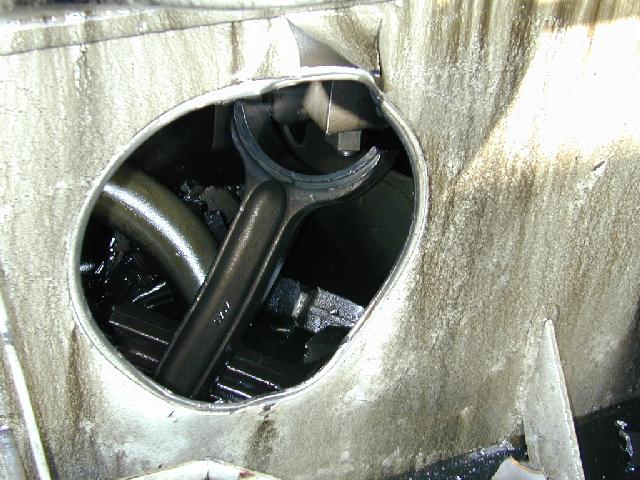
Near the bottom of the photo below you can see what is left of one broken connecting rod still attached to what is left of its piston. The rest of this piston is in several pieces laying outside the block and can be seen in the first photo of this series.
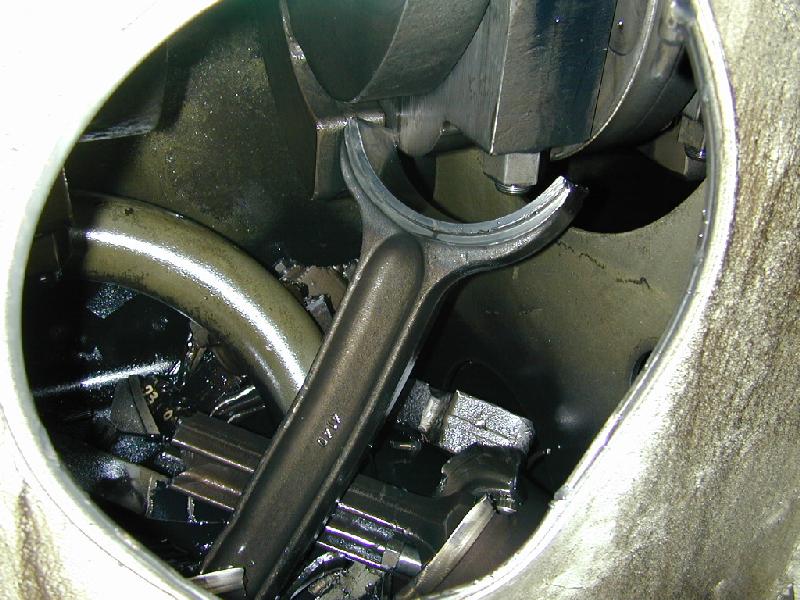
Finally we have a photo of the handhole cover that was broken off. It has a hole punched through it by the flailing rod or the exiting piston pieces.

Sheridan Depot Sheridan, Wyoming has to be one of very few towns its size (pop. 15,000) which has three generations of railroad depots still standing. Not only still standing but also in use by various enterprises. The current railroad depot is a ubiquitous steel building built in the mid 1980s. The previous depot of brick construction can be seen in other Krug Tales of this series. Below is a picture taken Oct 11, 2001 of the original 1890s era CB&Q depot and division offices. It has recently been remodeled and now houses several small businesses.
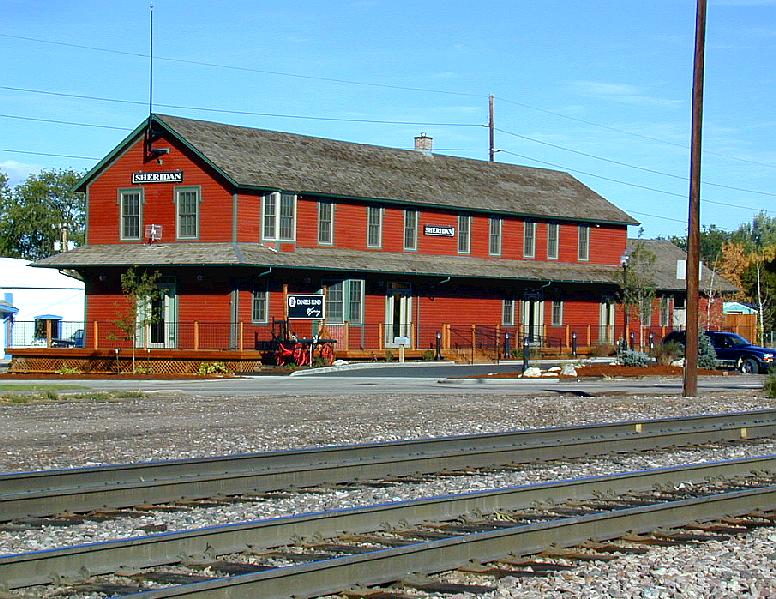
Steam Loco Across the street from the original depot and next to the second depot is our local steam locomotive display. The CB&Q 4-8-4 #5631 has just recently been patched and painted.
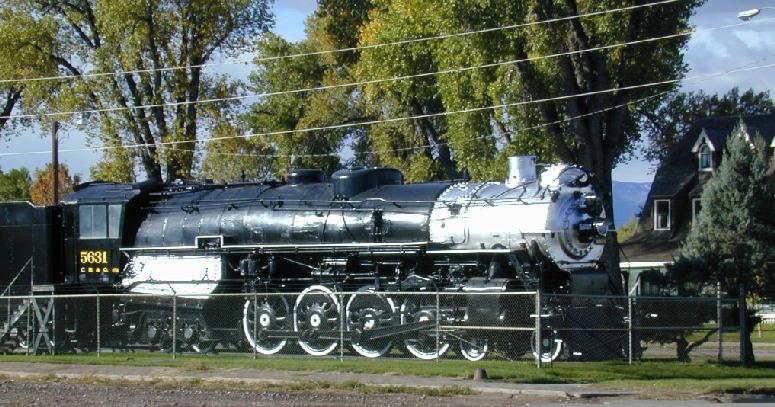
Obligatory Cab Shot For those who like such things here is a shot from the cab at MP 705 just a few hundred feet west of East Kiewit. At this location, 5 miles west of Sheridan, the track winds along Big Goose Creek through a series of 45mph "S" curves. Concrete ties begin here and continue through the sharpest of the curves.The area had many underground coal mines before the Great Depression and many signs of these old mines remain along the right of way. The level grassy right of way on the right of the photo is the former load-out track for Kiewit mine which was covered in a previous Tales. The rails are still there, though you can't see them in this picture, and used occasionally by the yard engine which services the truck-to-rail coal dump at the old tipple sight, 1.5 miles ahead around the bends.
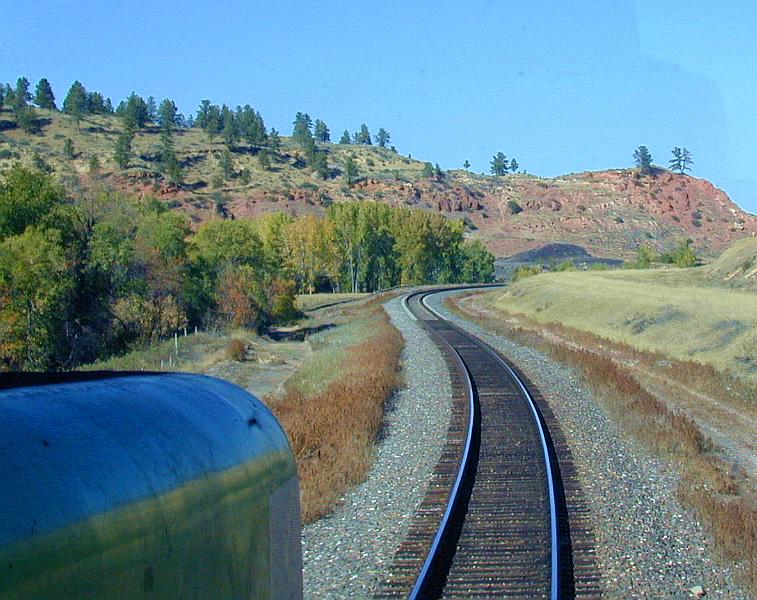
Train of Visitors

Return to Tales index My Home Page E-Mail me Created 10-11-2001
Updated 10-13-2001